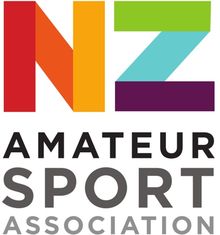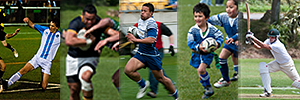Wellington's Ghost Clubs Part 10: Ten Ghost Club Identities
Above: the five Spencer brothers that played for Melrose, includingJack and George, the first brothers to represent New Zealand in both rugby codes in successive seasons.
WELLINGTON’S GHOST” RUGBY CLUBS
Part 10 – Ten Ghost Club Identities
Looking at some of the past identities from the long-forgotten former rugby clubs in Wellington.
“The Athletes Cigar”
The Rugby Football Club (1884)
In March 1884 the Leo and Ashley Football Clubs amalgamated to form the Rugby Football Club. Initially playing in light blue, in 1893 the Club changed its colours to maroon, black and gold.
David Christopher Ingram, the Club’s delegate to the Wellington Rugby Union, was made a Life Member of the club in 1894 “in consideration of past services”, including his role as Club Treasurer. The same year, Ingram published probably the first training book for athletes in New Zealand. The “Handbook on Athletes’ Training” contained articles on “How to Train,” “Starting,” "Diet,” and hints on running, jumping, hurdling, walking, swimming, rowing, football (Rugby and Association), cycling, and lawn tennis. There were also records of all branches of sport. “The book should prove of great interest to athletes” it was said. The rather delicious irony was that Ingram worked for “Austin Walsh & Co.”, a company which manufactured cigars and cigarettes from tobacco grown on Fijian plantations. In the era, smoking was considered to have certain health benefits.
“Brothers And Rivals”
The Rival Football Club (1884)
Formed in 1884, the Rival Football Club was one of six clubs which competed in the Wellington Senior Championship in the late nineteenth century. In 1890, the Club decided to merge its Senior team with Selwyn Club, with the intention to keep competing in the junior grades.
Ernest James Barnett, a Clerk at Philips and Pyke (import-export agents), initially played for Wellington Club, where the Barnett family had long-standing connections, before joining the Rivals in 1888 with his brother John Dennis Barnett (known as Dennis). Ernest made an impact at full-back and was selected to represent Wellington against Hawke's Bay in September of that year. Wellington won the match, 4-3. At this time, his older brother Louis, was captaining the Australasian Medical Student team in Edinburgh, which played against the leading clubs of Scotland. His younger brother Alfred, also played for the Rival Club in the Junior Cup.
“The Spencer Quintet’s Double Internationals”
The Melrose Rugby Football Club (1886)
Formed in 1886, the Melrose Rugby Football Club was one of Wellington’s finest before its ignominious demise in 1937, amid rumours of financial impropriety. Following a merger with Selwyn in 1932 (when it became known as “Melwyn”), the club folded shortly after a name change to “United” in 1936.

With grounds in Owen Street in Newtown, the Club played in red and blue hooped jerseys and socks. Thomas Spencer (senior), a Vice President of the Club purchased Lot 172 of the Brooklyn Estate in 1888 and there, with his wife Emma, raised five sons, two of whom were Wellington representatives throughout the first decade of the 20th century. All five boys George, John Clarence (known as Jack), Thomas William George, Walter and William John (known as Bill) played for Melrose. Jack (a lock forward) and George (fullback) both represented Wellington with distinction and were indispensable members of Wellington’s team, with both selected for the All Blacks in 1907. In 1908 both George and Jack switched to Rugby League and toured Australia with the New Zealand team in 1909, thereby becoming the first brothers to represent New Zealand in both rugby codes, in successive seasons.
“Roselle And Roseneath”
The Roseneath Football Club (1891)
Roselle’s Gymnasium at the back of McDonald’s Bakery on Manners Street was the place where “members [were] requested to roll up” for training. The Roseneath Football Club existed for a solitary year in 1891 when it was a member of the Wellington Junior Rugby Union, before merging with the Oriental Club in 1892. “Roselle’s Gymnastic Rooms” was where William Henry James Morkane, a young migrant from Otago, from where he qualified to work as a Clerk in the Government Insurance Office, trained. Identified as “a young and promising member of the club”, Morkane died in October 1891, at age 17, from typhoid and “brain fever”.
“The Southerners At Southern”
The Southern Rugby Football Club (1900)
Following a meeting at St Thomas’ school-room in Newtown in May 1899, it was decided to form a rugby football club to play under the style of the “southern football club”, (which was based in Dunedin).
The Southern Rugby Football Club was subsequently admitted to the Wellington Rugby Union in 1900. In 1908, a former South Canterbury representative, Edward Joseph Houlihan from Timaru, came to Wellington to assist the Club compete in the Senior Championship. Known as “Ted”, Houlihan was a storeman who lived at 23 Devon Street. He was a hooker and became Club Captain in 1910 and Captain of the Senior team in 1911. He was selected to represent Wellington in his first season with the Club.
His brother William Patrick, who joined the team in 1911, was wounded at Gallipoli, while Martin Thomas (the third brother who played for Oriental following his call-up to the Army), also served and represented the New Zealand Field Artillery team in 1918. Married to Florrie, Ted Houlihan died in Palmerston North in 1937.
“The Fruit Market Representative”
The Fruit Exchange Rugby Football Club (1909)
In 1906, a new Fruit Exchange was established in Allen and Blair Streets, off Courtenay Place.
In March 1909, the Fruit Exchange Football Club was affiliated to the Wellington Rugby Union “composed of employees at the fruit markets”. Playing in red and yellow hoops, the Club initially played in the Third Grade, before briefly becoming a Senior Club in 1910. Known colloquially at “the Exchange Club”, in 1913, there was a one-year merger with the Melrose Club, before the Exchange Club was resuscitated in the Third Grade in 1914. The Club boasted one Wellington provincial representative, Victor Leslie Allan who wore the Wellington jersey in 1914. Allan was a champion swimmer and member of the Island Bay Surf Life-Saving Club.
“The Handy Half-Back”
Miramar Rugby Football Club (1920)
While the first Miramar Football Club was formed for “the lower grades” in 1920, the Catholic Hall in Laing Street, Miramar, was the venue for the foundation of the Miramar Rugby Football Club in 1929, with “a special invitation extended to lady supporters”. The re-formed Club competed in the Senior Second Division, with aspirations to play in the Senior First Division.
An Old-Boy of Wellington Technical College (now Wellington High School), a former Poneke Senior player and Wellington mercantile representative cricketer, James Henry Potier joined the Miramar Club in 1938, following an embarrasing brush with the law. In 1939, a Wellington representative team was selected from the Union’s Senior Second Division sides to play Nelson. Potier it was noted, in an interesting journalistic play on words, was “very handy with his feet” and was selected at half-back. Before a crowd of approximately 6,000 spectators the touring Nelson side beat the Wellington representatives by 11 points to 8 at Athletic Park. Potier enlisted with the 2nd New Zealand Expeditionary Force in 1940 and played for the Army Club during World War 2.
“Khandallah’s All Black”
The Khandallah Rugby Football Club (1922)
In 1922, following its entry into the Sixth-Grade Competition, the fledgling Khandallah Rugby Football Club finished 28th out of 29 teams in the Wellington Rugby Union’s Club Championship. (Onslow Club, which was also formed in the same year, finished last.)
While the following year, the older players joined the Kaiwarra Club, a Seventh-Grade team (comprising boys aged under 14 and a half) was formed, coached by local Khandallah rugby identity, Alfred (“Alf”) John Griffiths, a North Island selector and former member of the Wellington and New Zealand Rugby Management Committees. It was presciently noted that in the Seventh-Grade team of 1923, “Alf Griffiths has good material, and he is bound to bring out some fine players from the ranks of one of the youngest teams playing football in Wellington.” In that team was Griffiths’ son, Jack Lester Griffiths who went on to make his All Black debut on 1 August 1934, aged 22. Jack played 30 matches (7 tests) and scored 50 points for New Zealand. For Wellington, he appeared in every back-line position, except Wing. As for the Khandallah Club, having created an All Black, it folded mid-way through the 1924 season.
“Duxie Of Seatoun”
The Seatoun Rugby Football Club (1929)
The Seatoun Rugby Football Club was formed in 1929 and subsequently re-named the “Seatoun and Rongotai College Old Boys Rugby Club in 1936”, before simply becoming the “Rongotai College Old Boys Club in 1939”. Based around the military base at Fort Dorset, which remained operational until 1957, one of the Club’s teams solely comprised players solely from the base.
The President of the Club was Wilfred Wulstan Cook, Registrar-General of Births, Deaths and Marriages for New Zealand, whose property on Mantell Street adjoined the base. Part of Cook’s property was requisitioned for use by the Government in World War 2. Cook was known affectionately by the label of '"Duxie," probably because of the habit he developed as a senior boy of Wellington College, always to be at the top, and perpetuated later by his urgent enthusiasm for the old school where he became Secretary of the Old Boys' Association. While the Club unsuccessfully applied for promotion to the Senior B Division, it was noted that “although the Club has not been fortunate enough to win the much-coveted championship in the past, the sociablity of the Rugby field has been enjoyed”.
“France At Woburn”
The Woburn Rugby Football Club (1945)
Formed in 1945, with three teams in Junior, Third and Fourth Grades, the Woburn Rugby Football Club mainly comprised Old-Boys of Hutt Valley High School and was based at the High School gymnasium. The Club played in an all-black jersey with a white monogram and black shorts.
The only recorded Wellington representative of the Woburn Club is G U (Graham Udall) France, who represented the province in 1949. France was a prominent member of the Hutt Valley High School 1XV, before joining the Woburn Club. He also received prominence as a boxer and had a long association with the Petone Rowing Club as a former President and Treasurer. In 1953, the Club changed its name to High School Old Boys, before amalgamating with the Hutt Club in 1967.
Steven White, 19 Mar 2019
Adam Julian, 19 Mar 2019
Steven White, 12 Mar 2019
Adam Julian, 04 Mar 2019
Steven White, 12 Feb 2019








.jpg)






